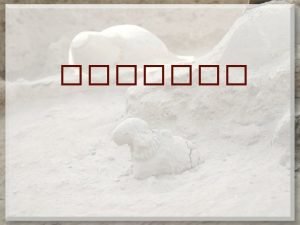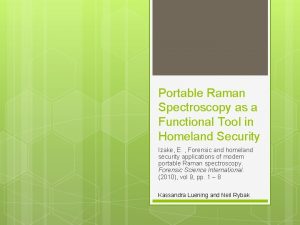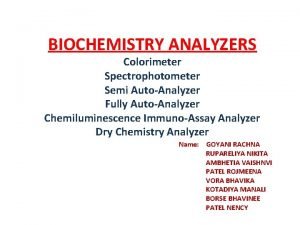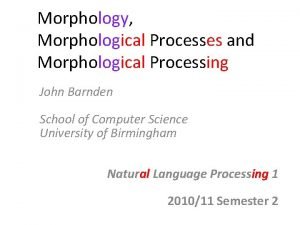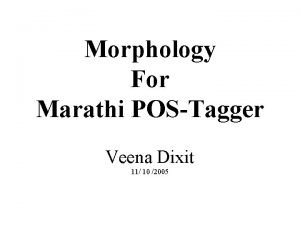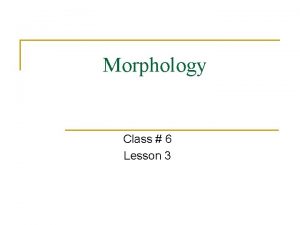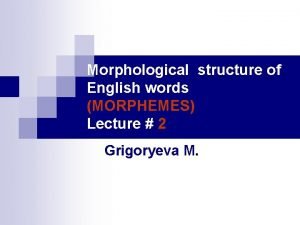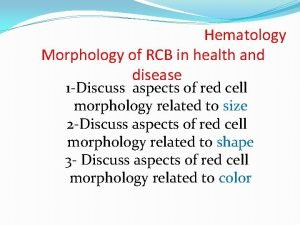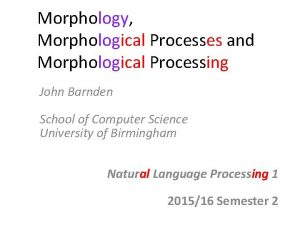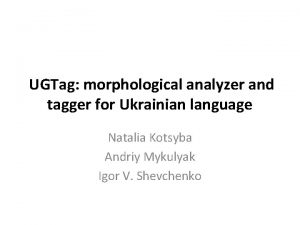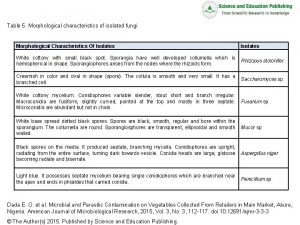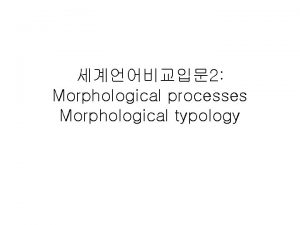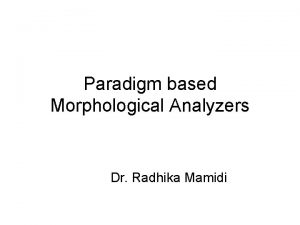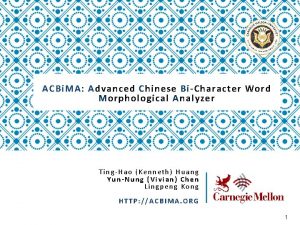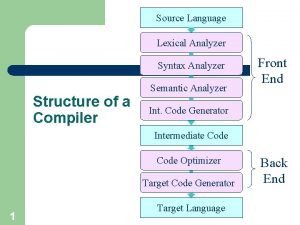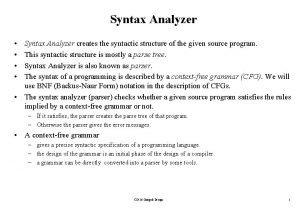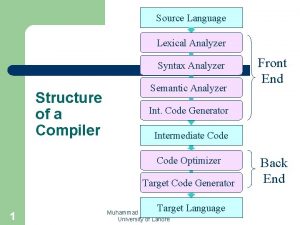Morphological Analyzer Morphological Analyzer is an essential and





















- Slides: 21



Morphological Analyzer • Morphological Analyzer is an essential and basic tool for building any language processing application. Morphological Analysis is the process of providing grammatical information of a word given with its suffix. Morphological Analyzer is a computer program which takes a word as input and produces its grammatical structure as output. Morphological analyzer will return its root/stem word along with its grammatical information depending upon its word category.

Morphological analyzer is playing important role in Natural Language Processing Applications

Rule-based Approaches • The rule-based approach has successfully been used in developing many natural language processing systems. Systems that use rule-based transformations are based on a core of solid linguistic knowledge. The linguistic knowledge acquired for one NLP system may be reused to build knowledge required for a similar task in another system. The advantage of the rule-based approach is 1) less -resourced languages, for which large corpora, possibly parallel or bilingual, with representative structures and entities are neither available nor easily affordable, and 2) for morphologically rich languages, which even with the availability of corpora suffer from data sparseness.

Tag sets The tagset which has been used for the present research work contains major 10 categories Noun (NN), Verb (VB), Adjective (ADJ), Adverb (ADV), Pronoun (PR), Postposition (POS), Conjunction (CJ), Particles (PAR), Numerals (NL) and Markers (CM) and subdivided into further 34 categories


Dictionaries • The dictionaries plays important role in morphological analyzer. The primary data for Morphological Analyzer have been collected from Classical Tamil Literature. From this, the root word list has been prepared and verified by language experts. The root words have been collected from the authentic editions of Classical Tamil Literature. The database contains the ten root word categories that dictionaries include: the Noun, Verb, Adjective, Adverb, Pronoun, Postposition, Conjunction, Particles, Quantifiers, Numerals, Markers and suffix. The size of database contains around 10, 000 words which includes all parts of speech categories

Plural markers • The different forms of plural markers in classical Tamil are kaḷ, mar, mār, ar, ār, ir, and īr. The ‘kaḷ’ forms in Tamil are in the different allomorphs of kaḷ, kkaḷ, ṅkaḷ, ṟkaḷ, and ṭkaḷ.

Segmentation rules Step 1: Read the input word If (word ) == (dictionary) assign the appropriate tag exit() Step 2: (suffix word) == (‘kaḷ’) { split the suffix assign tag as ‘PL’ assign the remain word tag as ‘NC/NP/ND’ exit() } Step 3: (suffix word) == (‘kkaḷ’) { split the suffix and remove the first character ‘k’ assign remaining suffix tag as ‘PL’ assign the remain word tag as ‘NC/NP/ND’ exit() }

Step 4: (suffix word) == (‘ṅkaḷ’) { split the suffix and remove the first character ‘ṅ’ assign remaining suffix tag as ‘PL’ add(m) in the last character of root word assign the tag as ‘NC/NP/ND’ exit() } Step 5: (suffix word ) == (‘ṟkaḷ‘) { split the suffix and remove the first character ‘ṟ’ assign remaining suffix tag as ‘PL’ add(l) in the last character of root word assign the tag as ‘NC/NP/ND’ exit() } Step 6: ( suffix word ) == (‘ṭkaḷ’) { split the suffix and remove the first character ‘ṭ’ assign the tag as ‘PL’ add(ḷ) in the last character of root word assign the tag as ‘NC/NP/ND’ exit()

Step 7: ( suffix word ) == (‘mār’) { split the suffix assign tag as ‘PL’ check the dictionary assign the appropriate tag exit() } Step 8: ( suffix word ) == (‘mar’) { split the suffix assign tag as ‘PL’ check the dictionary assign the appropriate tag exit() } Step 9: ( suffix word ) == (‘ar’) { split the suffix assign tag as ‘PL’ check the dictionary assign the appropriate tag exit() }

Step 10 : ( suffix word ) == (‘ār’) { split the suffix assign tag as ‘PL’ check the dictionary assign the appropriate tag exit() } Step 11 : ( suffix word ) == (‘ir’) { split the suffix assign tag as ‘PL’ check the dictionary assign the appropriate tag exit() } Step 12 : ( suffix word ) == (‘īr’) { split the suffix assign tag as ‘PL’ check the dictionary assign the appropriate tag exit() }

Step 1: The input word is read by the system and if it is found in the dictionary; then the appropriate tag is assigned. Ex. 1 If the given input ���� (makaḷ) is checked into the dictionary. Then the tag is assigned. The result is displayed as ����/NC (makaḷ/NC) ���� ��������� (��. 397: 1) eṉ makaḷ peru maṭam yāṉ pārāṭṭat (aka. 397: 1) Step 2: The suffix word ‘kaḷ’ is checked and if it is found, the segment is separated and assigned as ‘PL’. Then the remaining word is checked in the dictionary and assigned as ‘NC/NP/ND’. Ex. 2 If the given word is ������� (kiḷaikaḷ), the suffix ‘kaḷ’ is checked then the suffix is removed and assigned the tag as ‘PL’; the remaining part of the word is checked and if it is found in noun common category then the tag ‘NC’ is assigned; the result is ���� /NC ���/PL (kiḷai/NC kaḷ/PL). ������� ������� (����� 191: 2) kēḷ īvatu uṇṭu kiḷaikaḷō tuñcupa (Nālaṭiyār 191: 2)

Step 3: The suffix ‘kkaḷ’ is checked, if it is found the segment is separated; the first character (k) is removed; then it is tagged as ‘PL’, the remaining part of the word is assigned as ‘NC/NP/ND’. Ex. 3 If the given input is ���� (aṇukkaḷ). The suffix ‘kkaḷ’ is separated; the first character of the suffix ‘k’ is removed; then the remaining suffix is assigned as ‘PL’; check the remaining part of the word ‘aṇu’ in the dictionary; if it is found then the tag ‘NC’ is assigned; the result is ��� /NN ���/PL (aṇu/NN kaḷ/PL). ������� �������(�����. 27: 138) niṟainta iv aṇukkaḷ pūtamāy nikaḻiṉ (maṇimē. 27: 138) Step 4: The suffix ‘ṅkaḷ’ is checked. If it is found, the segment is separated; in the suffix ‘ṅ’ is removed; the remaining is tagged as ‘PL’; ‘m’ is added in the last character of the remaining part of the word and then it is tagged as ‘NC/NP/ND’. Ex. 4 If the given input is ���� (kuṇaṅkaḷ) the suffix ‘ṅkaḷ’ is separated; the first character of the suffix ‘ṅ’ is removed; and assigned tag as PL; ‘m’ is added as the last character of the remaining part of the word and assigned the tag as NC. The result is ����� /NC ���/PL (kuṇam/NN kaḷ/PL). �������� ����� (�����. 27: 256)

Step 5: The suffix ‘ṟkaḷ’ is checked. If ‘ṟkaḷ‘ is found, the segment is sepatated; in the suffix the ‘ṟ’ is removed; the remaining is tagged as PL; ‘l’ is added in the last character of the remaining part of the word and assigned the tagged as ‘NC/NP/ND’. Ex. 5 The given input is ������� (coṟkaḷ) check the suffix‘ṟkaḷ’ segment the first character of the suffix ‘ṟ’ is removed assign the remaining suffix as PL, add ‘l’ in the last character of the remaining word and assign the tag as NN, the result is ���� /NN ���/PL (col/NN kaḷ/PL). ������� ����� (��� 81: 13) tiruntupu nī kaṟṟa coṟkaḷ yām kēṭpa (Kali 81: 13) Step 6: The suffix ‘ṭkaḷ‘ is checked, if ‘ṭkaḷ‘ is found, the segment is sepatated; in the suffix the ‘ṭ’ is removed; the remaining is tagged as ‘PL’; ‘ḷ’ is added in the last character of the remaining part of the word and assigned the tagged as ‘NC/NP/ND’. Ex. 6 The given input is ������� (nāṭkaḷ) check the suffix ‘ṭkaḷ’ segment the first character of the suffix ‘ṭ’ then assign the remaining suffix is PL, add ‘ḷ’ in the last of the remaining word then assign the tag as NN. The result is ���� /NC���/PL (nāḷ/NN kaḷ/PL). ������� �������(����� 70 -56: 3)

Step 7: The suffix ‘mār’ is checked; the segment is separated and assigned as ‘PL’. Then the remaining word is checked in the dictionary and assigned as ‘NC/NP/ND’. Ex. 7 The given input is ���� (pāvaimār) check the suffix ‘mār’ segment the suffix and assign the suffix as PL, the remaining word is assign as NN. The result is ���� �/NC ����/PL (pāvai/NC mār/PL). ��������� (�������. 29: 120( pāvaimār ārikkum pāṭalē pāṭal (cilampu. 29: 120) ����� Step 8: The suffix ‘mar’ is cheeked; the segment is separated and assigned as ‘PL’. Then the remaining word is checked in the dictionary and assigned as ‘NC/NP/ND’. Ex. 8 the given input is ����(patiṉmar) check the suffix ‘mar’ segment the suffix and assign the suffix as PL, the remaining word is assign as NN. The result is �����/NC ��� /PL (patiṉ/NC mar/PL). �������� (���. 108: 48( muṉiyā ēṟupōl vaikal patiṉmarai (kali. 108: 48)

Step 9: The suffix ‘ar’ is cheeked; the segment is separated and assigned as ‘PL’. Then the remaining word is checked in the dictionary and assigned as ‘NC/NP/ND’. Ex. 9 the given input is ����(kiḻaviyar) check the suffix ‘ar’ segment the suffix and assign the suffix as PL, the remaining word is assign as NN. The result is �����/NC ���/PL (kiḻavi/NC ar/PL). ����������� (��� : 11: 120( kiḻavar kiḻaviyar eṉṉātu ēḻkāṟum (pari: 11: 120) Step 10: The suffix ‘ār’ is cheeked; the segment is separated and assigned as ‘PL’. Then the remaining word is checked in the dictionary and assigned as ‘NC/NP/ND’. Ex. 10 the given input is ���� (pētaiyār) check the suffix ‘ār’ segment the suffix and assign the suffix as PL, the remaining word is assign as NN. The result is ���� /NC ���/PL (pētai/NC ār/PL). ���������� ������� (���. 133: 10( aṟivu eṉappaṭuvatu pētaiyār col nōṉṟal (kali. 133: 10)

Step 11: The suffix ‘ir’ is cheeked; the segment is separated and assigned as ‘PL’. Then the remaining word is checked in the dictionary and assigned as ‘NC/NP/ND’. Ex. 11 the given input is ������(makaḷir) check the suffix ‘ir’ segment the suffix and assign the suffix as PL, the remaining word is assign as NN. The result is ����/NC ���/PL (makaḷ/NC ir/PL). ������� ��� ���. 20: 20 makaḷir kōtai maintar puṉaiya um pari. 20: 20 Step 12: The suffix ‘īr’ is cheeked; the segment is separated and assigned as ‘PL’. Then the remaining word is checked in the dictionary and assigned as ‘NC/NP/ND’. Ex. 12 the given input is ���� (peṇṭīr) check the suffix ‘īr’ segment the suffix and assign the suffix as PL, the remaining word is assign as NN. The result is �����/NC ��� /PL (patiṉ/NC īr/PL) ������ �������� (����. 5: 2( viḻaivu ilā peṇṭīr tōḷ cērvum uḻantu (tiri. 5: 2)

for testing and evaluation purposes, frequently-used 3257 words from classical Tamil were taken as input in the analyzer The result of word-level analysis is as follows: 2706 (83%) words were analyzed correctly; 359 (11%) words were analyzed wrongly and 194 (6%) of words were un-analyzed.

 Morphological analyzer python
Morphological analyzer python Characteristics of lipids
Characteristics of lipids Lepromin test ppt
Lepromin test ppt Advantages of alphabetical classification
Advantages of alphabetical classification Recognizing phonological and morphological elements
Recognizing phonological and morphological elements Portable raman analyzer for hazmat and narcotics
Portable raman analyzer for hazmat and narcotics Types of biochemistry analyzer
Types of biochemistry analyzer Morphological stylistics
Morphological stylistics Morphology pattern of acute inflammation
Morphology pattern of acute inflammation Agglutinative language
Agglutinative language Examples of morphological processes
Examples of morphological processes Meaning of morphology in marathi
Meaning of morphology in marathi Tree diagram of morphology
Tree diagram of morphology Morphological stylistic devices
Morphological stylistic devices Morphological structure of english words examples
Morphological structure of english words examples Morphological smoothing
Morphological smoothing Morphological patterns of acute inflammation
Morphological patterns of acute inflammation Exopterygota and endopterygota difference
Exopterygota and endopterygota difference Signs of low iron
Signs of low iron Morphological processes
Morphological processes Rcb disease
Rcb disease Mlaa
Mlaa
